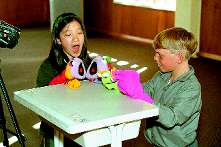|
The assessments
included twelve tasks which involved students in speaking for a number
of purposes.
 Six
of the tasks were identical for year 4 and year 8 students. The other
six tasks were in effect three pairs of tasks. Each pair had similar
instructions, marking procedures, and marking criteria, but differed
in the stimulus materials used. Six
of the tasks were identical for year 4 and year 8 students. The other
six tasks were in effect three pairs of tasks. Each pair had similar
instructions, marking procedures, and marking criteria, but differed
in the stimulus materials used.
Four of
the tasks are link tasks (to be used again in the year 2000) and therefore
are not described in detail here. The other tasks are released tasks
for which full details are given.
The chapter
presents the assessment results in the following order:
- the released
tasks attempted by both year 4 and year 8 students;
- the released
tasks attempted separately by year 4 and year 8 students;
- the four tasks
which will be used as link tasks, two of which were identical for year
4 and year 8 students and two of which were attempted separately.
Results across all
of the speaking tasks showed that higher percentages of year 8 than year
4 students were demonstrating strong abilities to articulate their ideas
effectively and use clear speech. In tasks involving conversational communications,
year 8 students were more resourceful, confident and engaging than year
4 students. The percentage of students showing weaknesses in expressing
ideas and information orally declined markedly from year 4 to year 8.
The generally consistent
pattern of gains from year 4 to year 8 across all tasks and dimensions
of speaking tends to confirm that developmental and experiential factors
lead to growing confidence and ability to use spoken language. |